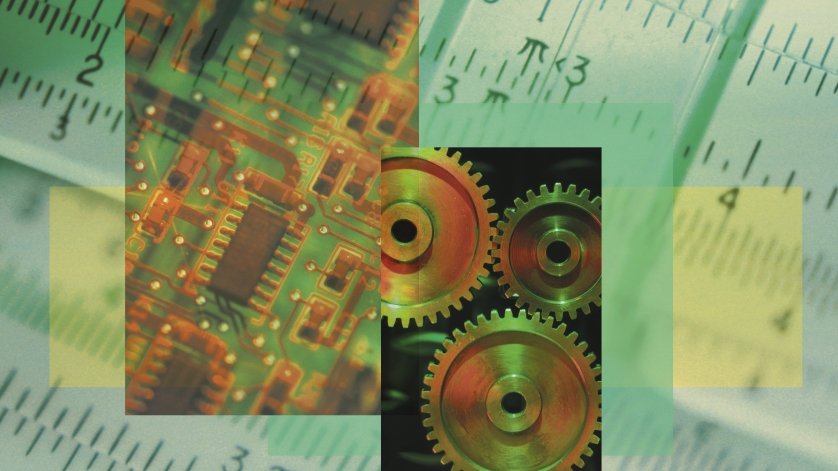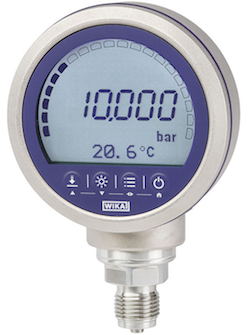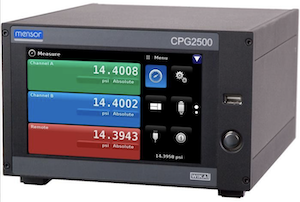
Today’s pressure gauges are remarkably robust and accurate, but they do lose accuracy over time. Regular calibration of pressure gauges is the best way to ensure that readings are reliable.

CPG1500 digital pressure gauge
Different applications call for different levels of pressure gauge accuracy, and the accuracy classes range from Grade B (±3/2/3% of span) up to the ±0.05% accuracy of digital pressure gauges. To ensure that pressure measuring instruments maintain their accuracy specifications, they require regular calibration. Simple recalibrations can be done onsite using a precision digital gauge, like the CPG1500, as a reference standard. An accredited lab can calibrate and certify both mechanical and digital gauges.
When to Calibrate a Pressure Gauge
Did you know that calibrations have a shelf life? Even when the pressure gauge is not in use, it does not stay calibrated indefinitely. And of course, mechanical wear causes gauges to drift over time.
Most pressure gauges are calibrated before they leave the manufacturing facility and won’t require recalibrating before installation, if the instruments are stored properly before being put into service. For best performance, gauges should be calibrated at regular intervals. How often depends on the application and industry. Here are some recommendations and best practices for when to calibrate an electrical or mechanical pressure measuring instrument:
- Before installation, especially if the instrument has been in storage for a while or was stored improperly (for example, in high heat)
- Once a year for most gauges after installation, such as during annual ISO audits
- Every three to six months for gauges used in pharmaceutical, biotechnology, and medical device applications. A more-frequent calibration interval assures quality control and avoids expensive errors, such as having to discard an entire production batch or paying a large fine as a result of inaccurate pressure measurements.
- During planned shutdowns for preventative maintenance
- Every five years for pressure balances, which are common pressure reference instruments
Most process plants swap out pressure gauges and other instruments based on their calibration cycle or during quarterly or semi-annual shutdowns. The spare gauges are verified onsite just before they are scheduled to be installed, then the removed gauges are sent to a calibration lab so that they will be ready for the next cycle. Setting up a regular calibration cycle minimizes the chances of inaccurate pressure readings. Doing so also improves monitoring and oversight of your processes.

CPG2500 precision pressure measuring instrument
How to Calibrate Industrial Pressure Gauges
For those who wish to handle their own calibration, WIKA offers a complete portfolio of reference instruments and calibration equipment for in-house labs and field use. These instruments include digital pressure gauges, pressure balances, test pumps and other portable pressure generators, hand-held pressure calibrators, and the CPG2500 digital pressure measuring indicator. Our calibration software simplifies and automates the calibration of up to 16 test items. WIKA-Cal then generates the necessary calibration certificates and logger protocols.
WIKA’s Calibration Lab for Pressure Instruments
WIKA’s calibration lab is accredited to ISO/IEC 17025, the worldwide standard for testing and calibration laboratories. In addition to calibrating pressure instruments, our experienced technicians can repair or refit damaged gauges, such as replacing the gauge movement, window, pointer, and more. Then they will make the necessary adjustments to bring your gauges back into published accuracy specifications. After servicing, all instruments are recalibrated before being shipped back to the customer. In most cases, the turnaround time is five or fewer business days.
For more information about our calibration instruments or full-service calibration lab, contact WIKA USA.
Products mentioned in this blog
• CPG1500 precision digital pressure gauge
• CPG2500 digital pressure measuring indicator


Is there such a thing present that once an instrument such as a pressure gauge is manufactured with said date(Date of Manufacture)…Will there also be an end of life date for that gauge even if that gauge has been in service IE an expiration date?
We do have a number of customers that set due dates for their gauges. Generally, this is the customer’s responsibility to designate but if the customer specifies beforehand what calibration interval they would like or a due date specified we can add a label in accordance with their request.
Best Regards,
Mathew Brown
Do pressure gauges which are just for Indicative purpose need calibration ?
It really all depends on the risk associated with that unit. If that measurement can result in damage to a machine, quality issues, or anything like that then calibration is a good idea. The requirement of calibration is really based on the process owner and their expectations as well as any industry or quality standard requirements.
Kind Regards,
Mathew Brown
We have a calibration cycle of one year at our manufacturing plant. Is there a value of error (like 50,100 psi) after which we should discard the pressure gauge?
Hello,
100 psi off on a 10,000 psi unit is a lot different than 100 psi off on a 500 psi unit. It depends on the unit’s accuracy and scale. I would say that gauges that exceed the manufacturer’s spec in a normal calibration interval should be put on a shorter interval after repair and monitored for accuracy drift. If it fails multiple times in a row then the unit should probably be replaced. This all really depends on the application, risk factor to the business, and each customer’s level of risk aversion.
Regards,
Mathew Brown
Is every single PG calibrated before it leaves the manufacturing facility, otherwise sampling is used per manufacturing lot, etc.(typically – where not specified by the purchaser)?
Rick,
Every gauge is calibrated and visually inspected prior to shipping. They do not each receive written calibration certification by default, but this can be purchased.
Regards,
Mathew Brown
I work for a company that used trucks with steel tanks that use an air pump to create vacuum and pressure in the tanks. Is there a regulation that would require the gauges that read the pressure/vacuum within the tanks to be calibrated or is it the company’s preference?
Dear Steven,
There is no such regulation. However, it really depends on the application and how critical the reading is. If a false reading could cause damage to the tank or the truck or pose any type of danger, a calibration check would be a good idea. It also depends on the operating conditions. If the gauge is exposed to a lot of vibrations, shocks, or pressure cycles, there is a chance that the calibration and accuracy will be affected by these conditions and a routine calibration check is definitely recommended.
Contact us if you have any other questions!
Best regards,
Hardy Orzikowski
Senior Product Manager
Mechanical Pressure & Temperature
Do gauges need to be calibrated by a 3rd party or in-house calibration by certified technician is acceptable for audit purposes?
This depends on the expectations and requirements of the auditor. Every gauge is factory calibrated and meets the stated accuracy. If required we can supply a NIST certificate which is similar to is a third-party certification. The question is how often does the gauge need to be re-certified by the factory or a third party. Again, it depends on the application, maybe industry standards. If we supply NIST certificate our recommendation for re-certification is every 12 months. However, this is only a recommendation and depends on operating conditions, internal requirements, or industry standards. For example, if a gauge is used to certify other gauges or to check the calibration of other gauges, you might want to certify it every 6 months instead of 12 months. I hope this answers your question.
Is there a regulation document or industry standard upon which the testing time/frequency and testing procedure was gotten? I checked the BS EN 837-(1,2,3) document and could not get much on this matter.
Thank you for your comment. A product manager should be reaching out to you shortly if they have not already.
Im a client representative and we have some pressure gauges of the contractor which shows differnent reading of the same pressure, do we need to bring a certified third party to calibrate and certify those gauges or we have just to repair them by the contractor bear in mind that the contractor is not certified for such things???.
It really depends on the application for these units. If these were purchased with certificates, I would highly recommend either sending them back to the original manufacturer or having a third party recertify. The problem with a third party is they may not have the means to repair/replace units that are not in spec. Depending on the age and application of the units, you may void warranties with a third party as well.
If the application is not very critical and you just want to verify, the contractor could probably test them with the appropriate test equipment to sort out units that do not meet specifications. When selecting testing equipment things can get pretty complicated. If you need help selecting testing equipment or discussing the application requirements further, please reach out to us at info@wika.com.
I’ve ordered a pressure gauge. The calibration cert states 06FEB2021 and also has a blank for ‘Date Calibration Cycle Begins’ and ‘Calibration Due Date’. When setting the calibration schedule (annual) for this gauge, should the next date be a year from the calibration cert date or a year from being placed into service/first use?
It really depends on your quality management system. For mechanical gauges typically the cal cycle begins from the time it is entered into service. For electronic it can really depend on the product.